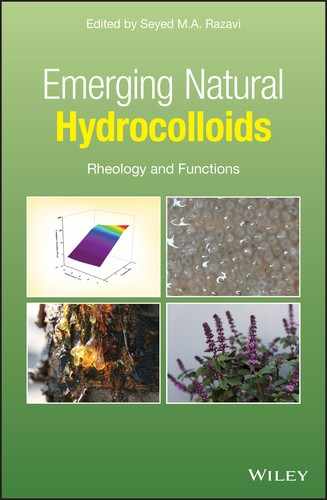Preface
Hydrocolloids are finely divided particles dispersed in water with long‐chained polymeric systems. Depending on the quantity of the medium, namely, water, hydrocolloids exist as sols or as gels. Hydrocolloids are versatile ingredients with a wide range of functions and applications, especially in modifying the rheology and texture of complex fluids.
Natural hydrocolloids, as biological macromolecules (mainly polysaccharides and proteins), are frequently used in various industries as stabilizing, thickening, fat replacing, flavor and bioactive encapsulating, edible coating/film, plasticizing, emulsifying, carrier, binding, and gelling agents. Compared to synthetic and semi‐synthetic hydrocolloids, natural hydrocolloids have distinct advantages, such as being nontoxic, sustainable, renewable, biodegradable, biocompatible, eco‐friendly, cost‐effective, readily available, and capable of chemical modifications. Moreover, the demand for natural products is increasing among health‐conscious consumers. For example, the growing demand for functional foods and increasing public awareness about the importance of fiber in diet have increased the consumption of various biopolymers in food products. This has resulted in the tremendous growth of the global hydrocolloids market in different industry sectors.
In recent years, an ever‐growing interest has been devoted to finding new sources of natural hydrocolloid with interesting functions in the product matrix. Therefore, an extensive range of studies has focused on the characterization of new sources (mainly plant gum exudates and seed gums) of hydrocolloids, which could be potential substitutes for commercial gums. In fact, scientists, technologists, and industries over the world have paid special attention to emerging hydrocolloids, especially the natural ones, owing to their functional and nutraceutical properties.
Since the aim is to replace the existing commercial (semi‐synthetic and synthetic) hydrocolloids by the natural ones for various applications, one needs to find novel hydrocolloids that perform certain unique functions for this purpose. In order to introduce the potential and applicability of novel hydrocolloids in industries, it is necessary to explore emerging hydrocolloids with the desired properties. So, in this book, the recent scientific papers, theses, and research works about emerging hydrocolloids have been reviewed in detail. This book contains 24 chapters prepared by outstanding scientists who have made a significant impact on the field of emerging natural hydrocolloids. This comprehensive set provides an updated and highly structured material for researchers in food, paper, oil, textile, paint, and pharmaceutical fields. It is also a valuable compendium of recent scientific progress, along with the best‐known applications of hydrocolloids in the food industry, to be used by researchers and technologists. Moreover, novel opportunities and ideas for developing the emerging hydrocolloids are highlighted.
I sincerely hope that this comprehensive compilation of studies on emerging natural hydrocolloids in book form is useful to researchers in the field, and I welcome any suggestions to improve the book and additional information on this subject.
Seyed M.A. Razavi
